This past Saturday evening, I had the pleasure of leading a workshop on ancient Egyptian magic at World Tree Healing bookstore and metaphysical resource center here in Chicago. Called “Hands-On Heka,” the workshop I devised featured an overview on the three types of magic, as I classify them, that we know that ancient Egyptians of all social strata practiced: funerary magic, ritual magic, and everyday (sometimes referred to as “crisis-mode”) magic. From this latter category, I devised a devotional ritual to the great goddess Sekhmet, Lady of Power, which featured a historically verified spell meant to reverse the Evil Eye. The spell involved the creation of a papyrus talisman, which we did together as a group based on a hieroglyphic prayer I created to evoke Sekhmet’s aid for spiritual protection. However, there was follow-up work for the ritual participants/workshop attendees to do once they returned to their homes: once activated, the papyrus talisman had to be “put to work” in what is arguably history’s oldest form of the Witch Bottle.
A Few Words on Egyptian Magic
This subject, of course, merits a series of blog posts. But for the purposes of contextualizing my ritual, it’s helpful to know the following.
The evidence for Egyptian magic spans thousands of years: the earliest recognizable amulets date back to the 4th millennium BCE (Before Common Era), and the earliest magical texts (the Pyramid Texts) to the 3rd millennium BCE.
Looking at cosmogony, the various creation accounts written by the ancient Egyptians, we see that it was a force—called heka—that existed from the beginning and had been essential to the creation and the maintenance of the world; it is older than all the Gods. It is also personified as a God, who was sometimes syncretized with the Creator (e.g., Ra, Ptah, or even the Primeval Mother, Mut), or described as the ba or manifestation of the Lord of the Sun. A Middle Kingdom text called the Instruction for Merikare says that the Creator gave magic to humanity “to ward off what may happen.” This phrase may signify misfortune but also disorder; the Egyptian word for both is izfet—the opposite of ma’at, or divine right order in the Cosmos.
Initially, magic was part of high culture. Much of the prestige of magic came from the exclusive access it gave people to special techniques, materials, or knowledge, and it was probably used more fully by the elite than by others. However, ordinary people had access to amulets that they wore (archaeological evidence for the use of amulets and talismans dates back to the 5th millennium BCE)—everyday magic was a prophylactic, an attempt to forestall the untoward, as the Instruction for Merikare expresses it.
Magic was also used in crisis mode, as it still is today in many parts of the world: people turned to it when normal agencies were ineffective, as in treating many illnesses, helping women in childbirth, or relieving the effects of things like snakebite or scorpion stings. Just as magic was indivisible from religion, it was also indivisible from medicine: they are two poles on a continuum of approaches to helping the afflicted and bringing about what one desired to happen. Both magic and medicine used exotic and complicated techniques to counter illnesses and afflictions, and their procedures and remedies overlapped to a great extent.
A unique feature of Egyptian magic was the belief that dangerous, evil powers needed to be enlisted to fight other dangerous, evil powers. “When something dangerous and chaotic had to be overcome, a being who possessed those qualities needed to be enlisted on your side” (Pinch 32). This underscores a widespread relativism that an energy that could be harmful in one context can be helpful in another: thus, fearsome deities like Set, Selket, Sekhmet, and Taweret could be enlisted to fight evils like the Apep serpent, scorpion stings, illnesses like plague, and the perils of childbirth, respectively. Furthermore, it was helpful for apotheosis—when the magician had to identify as the deity in question in order to execute a spell. So, for example, in the same way that the Gods benefitted from Set’s strength and energy to overcome Apep’s attack on the boat of Ra, a magician might harness Set’s power to overcome troublesome demons. This concept of “using evil to fight evil” is largely lost on contemporary Paganism, where people have difficulty admitting to the presence of evil to begin with.
My Ritual to Sekhmet
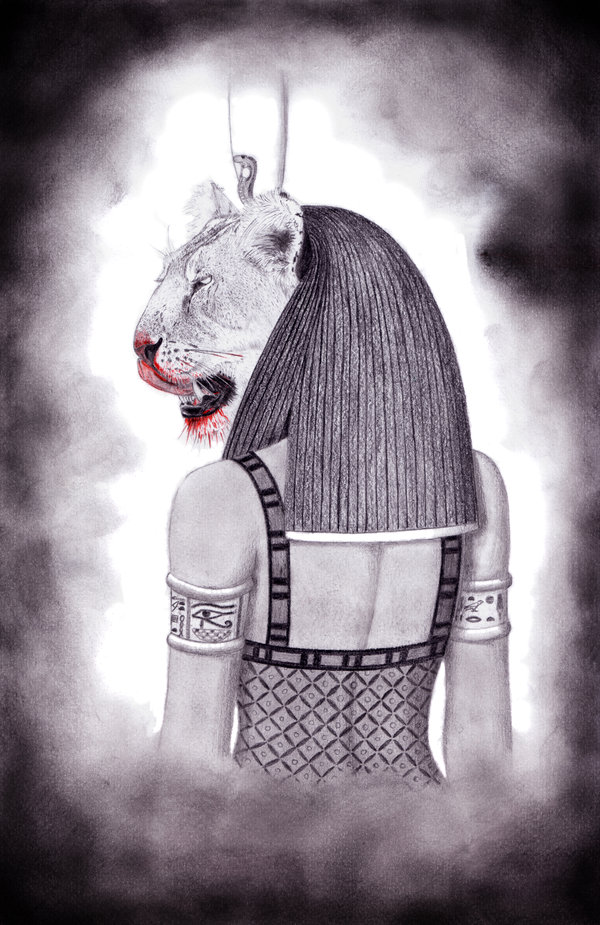
Closing the Temple
I purified the room serving as our temple space first with a mixture of sage and palo santo, then with a handmade blend of incense dedicated to Sekhmet, which I bought two years ago at Pagan Spirit Gathering. I asked the ritual participants to file in one at a time; I challenged each at the threshold of the room with a single question, to which they had a specific reply which was made known to them in advance:
Q: “How is it you come forth shining from the Field of Reeds with heka?”
A: “I am that pure Heka Who is in the utterance and the body of Ra. I am His ba, Heka. Hu is in my mouth, Sia is in my heart: my speech is the shrine of Ma’at.”
My Introductory Hymn, Sung in Egyptian:
Reҳ hᾱᾱiu I rejoice
Ma a-ᾴ paut Neteru May I look upon the company of the Gods.
Nuk ut’a tep ta ҳer Rᾱ mena-a nefer I am strong upon the earth before Ra,
Ẋer Ausȧr May my arrival be happy before Osiris
Nuk t’a pet I have sailed over heaven
Nuk ȧȧh I am the moon
Ba-ᾱ pu Neteru bai u en neheh My soul is the Gods, who are the Souls of Eternity
Au-ȧ ab kua neteri-kuᾴ I myself am pure, I am mighty
A net’-hra-k Nebet Iaret Homage to Thee, Lady of the Uraeus
A net’-hra-ten Nebu Heh Homage to Thee, Ye Lords of Eternity
Nuk ab per em seҳet I am the pure one coming forth from the field
Ȧn-na en Ɵen netersenƟer I have brought You incense
[BOW BEFORE PTAH’S IMAGE; ARMS IN OSIRIS POSE]
Tu a Neb-Ma’at You are Lord of Truth
Mesedjer-Sedjem The Ear That Hears
Ta-k-na uat seś-a em-hetep Grant to me a way that I may pass in peace
Ȧn-na kert ᾱb-kua I am silent, I am pure
Ĺ-nᾱ, ҳerk-k neb Ra I have come to Thee, O my Lord Ra
Reҳ hᾱᾱiu I rejoice
Reҳ hᾱᾱiu I rejoice
[BOW AND SHAKE SISTRUM]
[I PERAMBULATE THE ALTAR, SHAKING SISTRUM]
The Heavens are opened, the Earth is opened, the West is opened, the East is opened,
The Southern Half of Heaven is opened, the doors are opened,
And the gates are thrown wide open to Ra as He Comes Forth from the Horizon!
Invocation to Sekhmet
As it was at Mennefer, so be it now!
Thou who art Sekhmet, Life-Giver to the Gods,
Sekhmet, Lady of Flame,
Sekhmet, Great One of Magic,
Sekhmet, Eternal is Thy Name!
Mother in the Horizon of Heaven,
In the boat of Millions of Years,
Thou art the Great Defender!
Deliver us from the abode of fiends!
Hear us now, Weret! Great One!
Sekhmet, with lioness head,
Sekhmet, Whose color is red,
Sekhmet, Daughter of Ra,
Sekhmet, Consort of Ptah,
Mighty is Thy Name!
Thou art Ammi-Seshet,
Destroyer, Upholder!
Thou art the Terror before which fiends tremble!
Thou art Life!
Ever-burning One!
Hail, Lady of Plague,
Sekhmet the Great, Lady of Ladies!
Praised by Her father,
Eldest of Her Creator,
At the prow of Ra’s boat,
Roaming loose in its cabin!
Thine arms make light,
Thine rays brighten the Lands.
The Two Lands are under Thy command
And we are Thy people bringing Thee gifts!
With pleasing eyes, accept our offerings of red beer to slake Thy thirst,
Of spiced meat to quell Thy fierce hunger,
And candle flames to honor Thy incomparable Light!
O Lady, Mightier than the Gods,
Adoration rises unto Thee!
All beings hail Thee!
Mehenet!
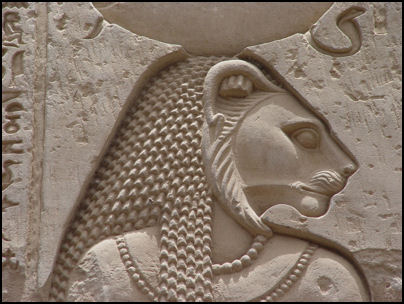
Attend unto us!
Bless the work we are to do as we make ourselves more fitting vessels
Of Thy Sekhem, O Lady of Power!
We call unto Thee!
Be with us this hour!
Hail, Sekhmet!
SA SEKHEM SAHU!
Everyone echoed the refrain: SA SEKHEM SAHU!
Recitation When Approaching Sekhmet with Offerings:
Even though I had brought the offerings of beer and a gyros platter to Sekhmet, along with a chalice of pure water, I asked each of the ritual participants to individually approach the altar and reverentially address Sekhmet, each stating that she or he had brought these offerings so that the Goddess would take notice of the person’s plea for spiritual protection.
O Sekhmet, Weret Heka, Nebet Senedi (O Sekhmet, Great in Magic, Lady of Fear),
Take to Yourself this beer and this meat,
Which I now offer to Your ka.
Sekhmet, how wondrous is Your sekhem (power), how great is Your beauty!
May You drink and eat heartily; may Your heart rejoice!
May anger be removed from Your face.
The offerings before You are pure;
I myself am pure.
I honor You, Nebet Iaret (Lady of the Uraeus)!
Dua (Hail) Sekhmet!
Apotheosis:
I then invited everyone to close their eyes and feel Sekhmet’s heat as She drew nearer to us and settled down around and within us—She who sees through all our bodies to the seat of our Heart, Our Ab. By this point, folks were definitely feeling Her energies. I asked everyone to close their eyes and prepare to welcome Her inside of themselves—to allow Her Sekhem, her Power, to fuse with theirs so that they could be empowered to do the work that they came here to do—to turn themselves from victims to victors. “She is here, She will aid us in all our undertakings,” I said. I then asked everyone to repeat after me, line by line, this call to apotheosis with Sekhmet:
Behold, I smell the earth before the Mighty One.
Behold, I have kept the vigil in the shrine of Sekhmet.
Behold, I am the child,
The child of Sekhmet,
Lady of the Burning East,
Lady of the Sunkissed South.
I am one with Her. I am one with Her.
I am Sekhmet and the flames of all who praise Her.
I am the hand of the Nebet Sekhem,
She who wears the Solar Disk.
I am the Twice-Beautiful One,
More splendid than Yesterday.
I am She who goes forth with Ra.
I am She.
My hair is the hair of Sekhmet, the Golden One.
My eyes are the eyes of the lioness.
My ears are the ears of the goddess.
My nose is the nose of She Who Can Sniff Out All Evil.
My teeth are the fangs, which can devour the darkness
My neck is the neck of the Shining One
My hands are Her hands with long claws
My forearms are Her forearms, coiled to spring
My backbone, my djed pillar, is formed in Her strength and beauty
My chest is the chest of the Mighty One of Terror,
Slayer of the Foes of the Gods.
My belly and back are the belly and back of Sekhmet,
Secure in Right Order
My buttocks are strong,
My hips and legs are strong,
My feet are the clawed feet of the Eye of Ra.
There is no part of me that is not of the goddess.
I am Sekhmet who cometh forth in the dawn.
I am the Power of Ra by day.
I shall not be dragged back by my arms
And none shall lay violent hands upon me,
Lest I destroy them utterly.
Neither man nor god shall hurt me,
Nor any living thing,
Nor shall the dead detain me,
Nor shall demons destroy me in battle,
For I am Sekhmet
And I shall rip off their faces
I Am She Who Cometh Forth
I am the Seer of Millions of Years
I am the Sekhem of the Divine Judge
I dwell in the South
I am the Lady of Eternity, the Unveiled One,
My Name is created to defy all evil.
I am the flame that shineth in the sanctuary,
That blazes forth in the Duat,
The avenging Force before Whom wrongdoers tremble in terror.
I am Sekhmet.
SA. SEKHEM. SAHU.
Anti-Evil Eye Spellwork:
Before we had begun the ritual proper, I had distributed sheets of papyri and asked the ritual participants to copy by hand my hand-drawn hieroglyphic prayer:
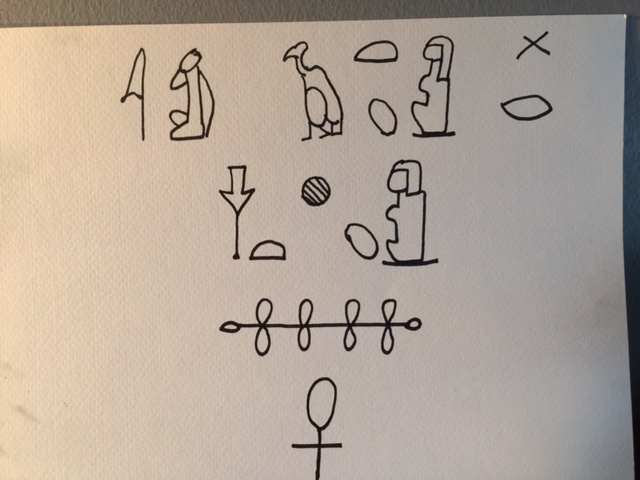
In Egyptian, the prayer reads: “Dua, Mut Ur! Sekhmet! Sia! Ankh!”
From top to bottom, the prayer reads: “Hail Mother Great, Sekhmet! Grant protection and life.”
After reciting the Words of Power to achieve apotheosis, it was time to activate the papryi by reciting the following Anti-Evil Eye Spell four times, as the number four was extensively used magically by the ancient Egyptians to solidify a working:
Sekhmet’s arrow is in you, the heka of Thoth is in your body,
Isis curses you, Nephthys punishes you, the lance of Set is in your head!
They treat you again and again, you who are in the furnace of Horus in Shenwet,
The Great God Who sojourns in the House of Life!
He blinds your eyes, oh all you people, you who cast the evil eye against [PARTICIPANT’S NAME],
Born of [PARTICIPANT’S MOTHER’S FIRST AND MAIDEN NAME], in any secret or open manner!
You will be slain like Apep, you will die and not live forever!
Sharing of Libations/Blessed Beer:
The energy in the room was enough to catapult me into a slightly dizzy state by that point. It was time to cool down Sekhmet’s heat with some cool beer: I find that She likes a craft beer called Sagefight Imperial IPA by Deschutes. It has sage and juniper berry extracts, both of which are apotropaic herbs. I raised high the beer-filled goblet and said:
“Sekhmet, Powerful One, when Ra made the decision to not have humanity destroyed after all, the beer maidens crafted many large vats of dyed beer and spilled it out into the fields to entice You, and lo! The beverage was pleasing to You, and holy intoxication was Yours—thereby sparing humanity from Your full wrath. May You never direct Your wrath towards any of us, towards any of those here on earth who know You, who honor You, and speak your Names with praise and loving hearts. Mighty and Ancient One, beloved Mother of Nefertum, the healing god, may this beer be blessed and shared with Your awesome sekhem, and as we drink of it and pass it around, may our words of praise for You flow freely, reaching Your ears, bringing You gladness.
“So, my companions, let us now think of things we are grateful for to Sekhmet and say them aloud before we have our sip of beer and then pass the goblet along to the next person.
“If you can’t consume alcohol, or if you’re ill, please touch the goblet to your forehead as a gesture of respect before speaking your words of praise to Sekhmet. Speak freely from your heart.
Hail, Sekhmet!”
ALL: Hail!
Opening the Temple
Thanksgiving to Sekhmet:
Glory unto You, Mighty One!
Fierce Lioness, Roamer of the Deserts,
Protect us in our battles and destroy our enemies.
Great Lady of Fierce Flame,
You burn away our falsehoods and leave us with the truth.
Your roar shatters all illusions.
We feel Your piercing hot breath on the winds, blowing clarity into our lives.
Warrior, empower us as You devour our weaknesses!
Watch over us always!
Hail, Sekhmet!
ALL: Hail!
Final Proclamation:
Repeat after me:
Reҳ hᾱᾱiu I rejoice!
Ba-ᾱ pu Neteru My soul is the Gods, who are the Souls of Eternity.
There is no part of us that is not of the Gods. Blessed are those who would listen and know.
Follow-Up Work for Participants to Do At Home
The ritual spellwork certainly didn’t end with the conclusion of the workshop that night. This is the “after-care” set of instructions I asked each participant to do upon returning home:
- Anoint papyrus spell with your saliva, sexual fluids, menstrual blood (if applicable), or urine
- Fold up papyrus spell four times (facing you) and place in jar containing crushed garlic and beer
- Either bury on your property or hide in an inconspicuous place (preferably near a threshold) to deter evil from crossing into your dwelling
This is what mine looked like when I finished adding the contents; the jar is about 10 ounces. I then sealed the cork with sealing wax and have since buried the bottle.
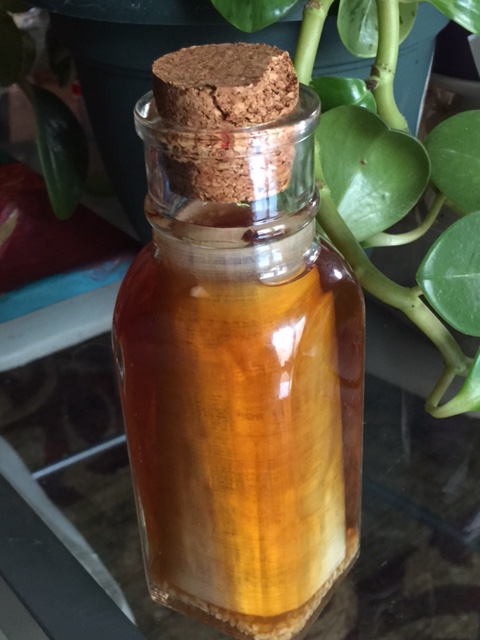
Give this ancient Egyptian Witch Bottle a try if you’re eager to “return to sender” the Evil Eye! Seneb-ti–blessings!
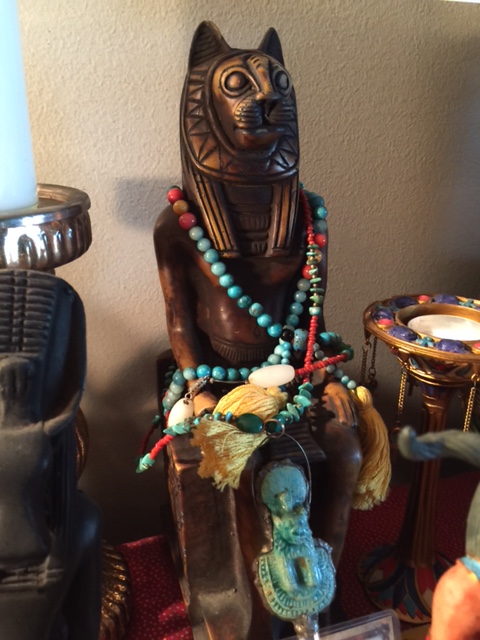
My Egyptian-made statue of Sekhmet is very alive with Her ba, or manifestation! I made for Her as an offering the set of turquoise prayer beads with Egyptian faience Sekhmet pendant.
Works Cited and Suggested Reading
Primary Sources
Betz, H.D., ed. The Greek Magical Papyri in Translation. Chicago: University of Chicago Press, 1992.
Budge, E.A. Wallis. The Ancient Egyptian Book of the Dead: The Papyrus of Ani, Egyptian Text Transliteration and Translation (reprint of 1888 unabridged original). Mineola, NY: Dover Publications, 1967.
Faulkner, R.O. The Ancient Egyptian Coffin Texts. 3 vols. Warminster: Aris & Philips, 1973-1978.
—–. The Ancient Egyptian Pyramid Texts. Oxford: Clarendon, 1969.
- Griffith and Herbert Thompson, eds. The Leyden Papyrus: An Egyptian Magical Book. Mineola, NY: Dover Publications, 1974.
Secondary Sources
Budge, E.A. Wallis. Egyptian Magic (reprint of 1901 original). Mineola, NY: Dover Publications, 1971.
Clark, Rosemary. The Sacred Magic of Ancient Egypt. St. Paul: Llewellyn Publications, 2003.
Ford, Michael W. Necronomicon: Egyptian Sethianic Magick. Houston: Succubus Productions, 2013.
Harris, Eleanor. Ancient Egyptian Magic. Newburyport, MA: Red Wheel/Weiser Books, 1998.
Pinch, Geraldine. Magic in Ancient Egypt. Austin: University of Texas Press, 2006, revised ed.
Rankine, David. Heka: The Practices of Ancient Egyptian Ritual & Magic. London: Avalonia, 2006.
Shafer, Byron, ed. Religion in Ancient Egypt: Gods, Myths, and Personal Practice. Ithaca: Cornell U. Press, 1991.
Skinner, Stephen. Techniques of Graeco-Egyptian Magic. Woodbury, MN: Llewellyn Publications, 2014.
Taylor, John H. Death and the Afterlife in Ancient Egypt. Chicago: University of Chicago Press, 2001.
Teeter, Emily. Religion and Ritual in Ancient Egypt. Cambridge, England: Cambridge University Press, 2011.

This is a wonderful ritual and spell! Thank you so much for sharing!!
LikeLiked by 1 person
Thank you, love! I wish you could have been there! XOXOXO
LikeLiked by 1 person
XOXOXO
LikeLike
Reblogged this on Gangleri's Grove and commented:
awesome protective ritual to Sekhmet…reblogging because it is awesome. 🙂
LikeLiked by 1 person
Thank you, Galina! Blessings!
LikeLike